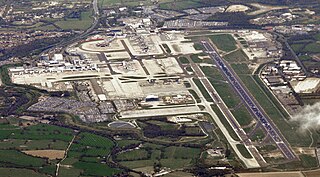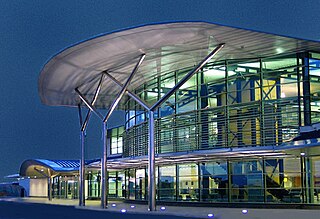
London Gatwick, also known as Gatwick Airport, is the secondary international airport serving London, England. It is located near Crawley, West Sussex, England 29.5 miles (47.5 km) south of Central London. In 2022, Gatwick was the second-busiest airport by total passenger traffic in the UK, after Heathrow Airport, and was the 8th-busiest in Europe by total passenger traffic. It covers a total area of 674 hectares.

Flybe, styled as flybe, was a British airline based in Exeter, England. Launched in 1979 as Jersey European Airways, and renamed Flybe in 2002, at various points it was the largest independent regional airline in Europe, and provided more than half of the UK domestic flights outside of London.

British European Airways (BEA), formally British European Airways Corporation, was a British airline which existed from 1946 until 1974.

Caledonian Airways was a wholly private, independent charter airline in the United Kingdom formed in April 1961. It began with a single 104-seat Douglas DC-7C leased from the Belgian flag carrier Sabena. Caledonian grew rapidly over the coming years to become the leading transatlantic "affinity group" charter operator by the end of the decade. During that period, passenger numbers grew from just 8,000 in 1961 to 800,000 in 1970. The latter represented 22.7% of all British non-scheduled passengers. It also became Britain's most consistently profitable and financially most secure independent airline of its era, never failing to make a profit in all its ten years of existence. By the end of 1970, Caledonian operated an all-jet fleet consisting of eleven aircraft and provided employment for over 1,000 workers. At that time, its principal activities included group charters between North America, Europe and the Far East using Boeing 707s, and general charter and inclusive tour (IT) activities in Europe utilising One-Elevens.

Dan-Air was an airline based in the United Kingdom and a wholly owned subsidiary of London-based shipbroking firm Davies and Newman. It was started in 1953 with a single aircraft. Initially, it operated cargo and passenger charter flights from Southend (1953–1955) and Blackbushe airports (1955–1960) using a variety of piston-engined aircraft before moving to a new base at Gatwick Airport in 1960, followed by expansion into inclusive tour (IT) charter flights and all-year round scheduled services. The introduction of two de Havilland Comet series 4 jet aircraft in 1966 made Dan-Air the second British independent airline after British United Airways to begin sustained jet operations.

Guernsey Airport is an international airport on the island of Guernsey and the largest airport in the Bailiwick of Guernsey. It is located in the Forest, a parish in Guernsey, 2.5 nautical miles southwest of St. Peter Port and features mostly flights to Great Britain and some other European destinations.

Eastern Airways, legally incorporated as Air Kilroe Limited, is a British regional airline headquartered at Humberside Airport near the village of Kirmington, North Lincolnshire, England. The airline operates domestic, international and private charter flights. Around 800,000 passengers fly with the airline per year.
Ghana International Airlines (GIA) was the national airline of the Republic of Ghana between 2005 and 2010. The airline suspended operations on 13 May 2010.
Highland Airways was an airline based in Inverness, Scotland. It ceased trading on 24 March 2010 after failing to secure new investment. The airline operated passenger and freight charters as well as scheduled services from its main base at Inverness Airport. Other services included newspaper distribution to the northern and Western Isles and, until recently, charter services for corporate clients. Highland Airways was under talks for a buyout by Perth-based, Air Charter Scotland. Aircraft were also based at Cardiff Airport.

British United Airways (BUA) was a private, independent airline in the United Kingdom formed as a result of the merger of Airwork Services and Hunting-Clan Air Transport in July 1960, making it the largest wholly private airline based in the United Kingdom at the time. British and Commonwealth Shipping (B&C) was the new airline's main shareholder.
British United Island Airways (BUIA) was formed in November 1968 as part of a reorganisation of the BUA group of companies. It was a regional sister airline of British United Airways (BUA), Britain's largest wholly private, independent airline of the 1960s. It operated a network of regional, short-haul scheduled routes linking a variety of destinations within Europe, including year-round services from both Channel Islands to BUA's Gatwick base.

British Island Airways (BIA) was the legal successor to British United Island Airways (BUIA). It commenced operations under that name in mid-1970. Ten years later it merged with Air Anglia, Air Wales and Air Westward to form Air UK, at the time the United Kingdom's biggest regional airline and its third-largest scheduled operator. The first British Island Airways had its head office at Congreve House (1970–1972) and Berkeley House (1973–1979), which are respectively located in Station Road and on the high street in Redhill, Surrey.

British Eagle International Airlines was a major British independent airline that operated from 1948 until it went into liquidation in 1968. It operated scheduled and charter services on a domestic, international and transatlantic basis over the years.
Lloyd International Airways Ltd was a private, British independent airline formed in 1961 to operate worldwide charter flights. It commenced operations with a single Douglas DC-4 piston airliner from Cambridge Marshall Airport. Lloyd International concentrated on passenger and cargo charters with four-engined, long-range aircraft. It also had links in Hong Kong since its inception and flew to the Far East regularly. During the mid-1960s, the airline began re-equipping its fleet with Bristol Britannia and Canadair CL-44 turboprops, all of which featured large cargo doors and palletised freight systems. Long-range Boeing 707 jets joined the Lloyd International fleet during the early 1970s for use on affinity group passenger and freight charters to North America and the Far East. Lloyd International ceased operations in June 1972.
British Caledonian (BCal) came into being in November 1970 when the Scottish charter airline Caledonian Airways, at the time Britain's second-largest, wholly privately owned, independent airline, took over British United Airways (BUA), then the largest British independent airline as well as the United Kingdom's leading independent scheduled carrier.

British Airways CityFlyer is a British regional airline, and a wholly owned subsidiary of British Airways with its head office based in Didsbury, Manchester, England. It operates a network of domestic and European services from its base at London City Airport. All services operate with BA's full colours, titles and flight numbers. BA Cityflyer Limited holds a United Kingdom Civil Aviation Authority Type A Operating Licence, meaning that it is permitted to carry passengers, cargo and mail on aircraft with 20 or more seats.
ACE Freighters was a British cargo airline from 1964 to 1966.

Jersey Airlines was an early post-World War II private, independent British airline formed in 1948. In 1952, the airline operated its first scheduled service. Four years later, British European Airways (BEA) took a 25% minority stake in Jersey Airlines and made it an "associate". In June 1958, a Jersey Airlines de Havilland Heron became the first commercial airliner to arrive at the newly reconstructed Gatwick Airport. In 1960, Jersey Airlines ordered four state-of-the-art Handley Page Dart Herald 200 series turboprops. By 1962, BEA had sold its 25% minority holding in Jersey Airlines. The same year, Jersey Airlines became part of the British United Airways (BUA) group of companies. In August 1963, Jersey Airlines changed its trading name to British United (C.I.) Airways. Following the BUA group's 1967/8 reorganisation, BUA (C.I.) was absorbed into British United Island Airways (BUIA) in November 1968.
Gatwick Airport was in Surrey until 1974, when it became part of West Sussex as a result of a county boundary change. The original, pre-World War II airport was built on the site of a manor in the parish of Charlwood. The land was first used as an aerodrome in the 1920s, and in 1933 commercial flights there were approved by the Air Ministry.

Flybe, styled as flybe, was a British regional airline based at Birmingham Airport, England. It commenced operations using the name of a former airline in 2022, but ceased operations and entered administration on 28 January 2023.















